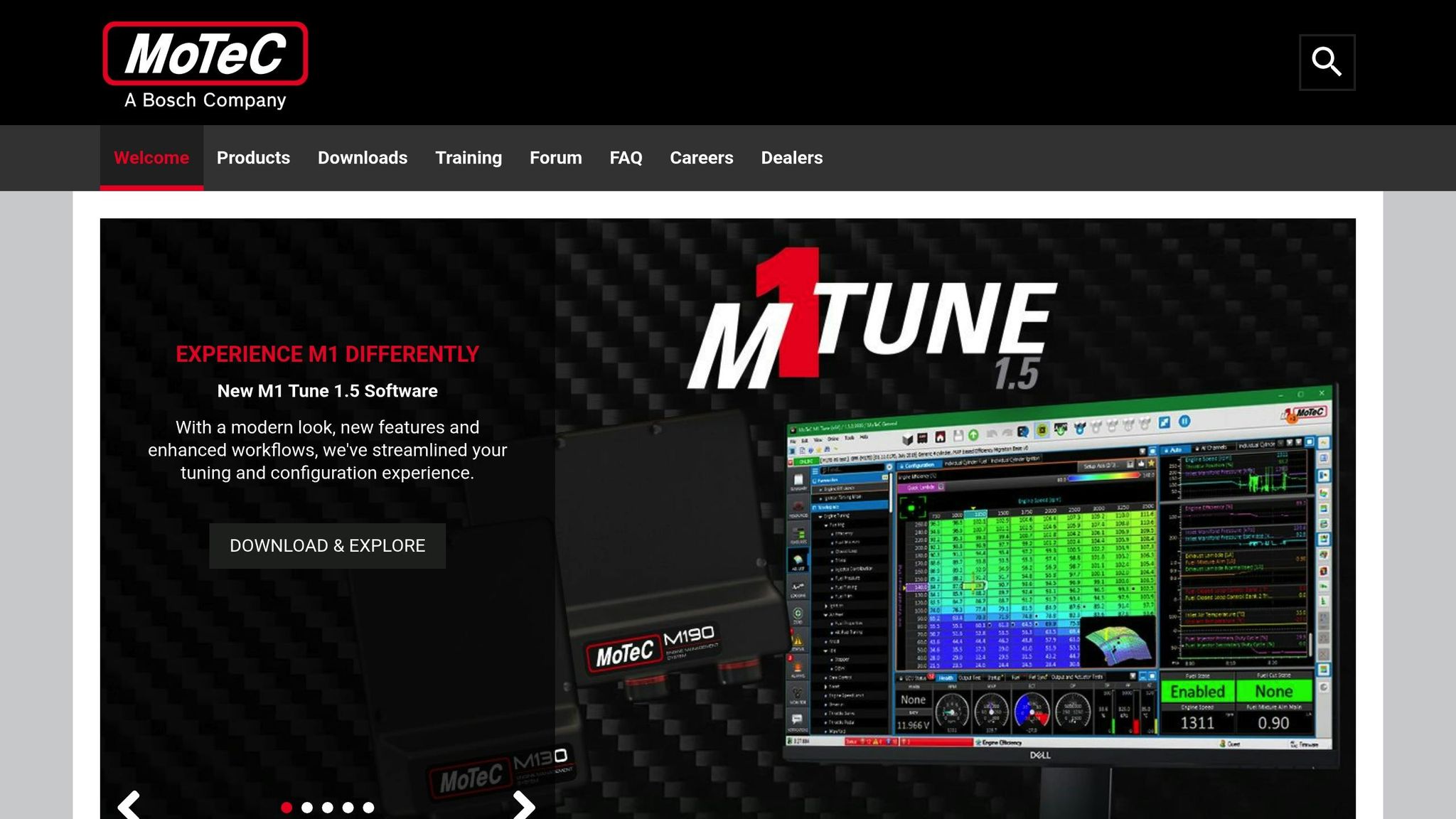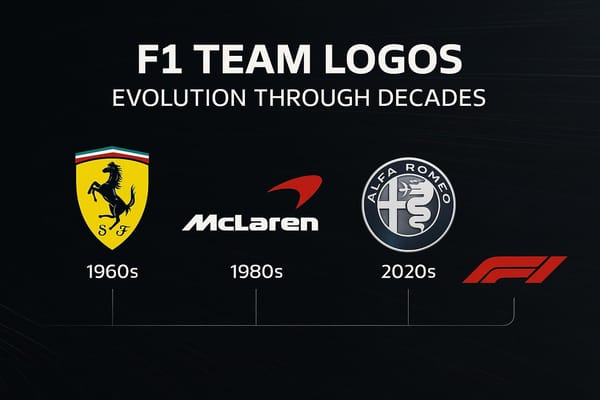How Telemetry Data Storage Impacts F1 Budgets
Explore how telemetry data storage influences F1 budgets, highlighting cost management strategies and innovative technologies for performance gains.

Formula 1 teams collect massive amounts of telemetry data during race weekends - up to 1.5 terabytes per car. Managing this data involves high costs for transmission, storage, and processing, which must fit within strict budget caps. Teams balance these expenses with car development, logistics, and other priorities. Strategies like edge computing, AI-driven automation, and tiered storage systems help reduce costs without sacrificing performance. Examples include McLaren's predictive data storage, Aston Martin's trackside processing, and Alpine's shared infrastructure. These approaches ensure smarter spending on data systems, directly supporting better results on the track.
Telemetry Data Basics and Associated Costs
What is F1 Telemetry Data?
Telemetry data is at the heart of every modern Formula One car, acting as its digital lifeline. Each car is equipped with more than 300 sensors that constantly monitor performance metrics during race weekends. These sensors track everything from tire temperatures and brake pressures to fuel usage and aerodynamic behavior - all in real time.
The sheer amount of data generated is staggering. A single F1 car produces about 1.5 terabytes of data over a race weekend. For a two-car team, this translates to 11.8 billion data points across a season, with roughly 160 terabytes of data processed during a Grand Prix weekend. Managing this flood of information requires significant resources, making data transmission, processing, and storage a costly endeavor for teams.
Data flows seamlessly from the car to the pit wall via high-speed wireless connections, allowing engineers to monitor performance and make split-second decisions. However, storing and analyzing such massive datasets demands advanced systems, which come with hefty price tags.
Take McLaren, for example. They transport 140 terabytes of solid-state storage to every race, while their computational fluid dynamics (CFD) analysis generates a jaw-dropping 99 petabytes of data. Handling this scale of data has led to three key areas where costs pile up.
"The IT team here at McLaren is a lean group, but our role is to ensure we provide platforms, technology and tools that the various teams within the Formula 1 group need to be as efficient as possible." - Edward Green, Head of Commercial Technology, McLaren
Main Cost Factors in Telemetry Data Storage
The enormous volume of telemetry data drives up three primary cost areas that weigh heavily on team budgets: data transmission, cloud processing, and cloud storage. Of these, data transmission is the most significant expense.
Data transmission costs are high because teams rely on fast, reliable connections to send vast amounts of data from the racetrack to their headquarters. To ensure uninterrupted communication during critical moments, teams often invest in dedicated bandwidth and backup systems, further increasing costs.
Cloud storage and processing fees also represent a major financial burden. While storing small amounts of data in the cloud might seem inexpensive for individuals, scaling up to the level required by F1 teams is a different story. As one expert explains:
"Data transmission is obviously the most significant of these. Less important, but often surprising, is the cost of data storage. An individual, private user can store small amounts of data in a commercial cloud for free. But scaling to large, secure, and managed storage incurs significant charges." - Aplicom
The FIA cost cap has added another layer of complexity to managing these expenses. To level the playing field, teams are now limited to budgets of $145 million in 2021, $140 million in 2022, and $135 million for 2023-2025. These restrictions force teams to carefully evaluate their IT investments, often requiring tough choices between data infrastructure and other performance-related areas.
Freight weight costs also add up quickly. With transportation costs hovering around $500 per kilogram, the near-weekly travel required for portable data centers becomes a significant expense. Teams must strike a balance between the computing power they bring to the track and the cost of transporting it.
McLaren tackled this issue early on. Edward Green highlighted how they used advanced analytics tools to understand the true cost of their operations:
"This was one of the first applications of the Alteryx system for McLaren Racing: to figure out the real cost of the car and all the resources required." - Edward Green, Head of Commercial Technology, McLaren
Lastly, infrastructure maintenance adds to the ongoing costs. Redundant systems, backup power supplies, and specialized cooling equipment are essential to keep operations running smoothly, both at the track and back at their headquarters. These expenses remain a constant challenge throughout the racing season.
How Telemetry Data Storage Affects F1 Team Budgets
IT and Data System Budget Allocation
F1 teams face the tricky task of juggling their telemetry infrastructure investments with other key priorities like aerodynamics, engine development, and driver performance. With budgets capped, every dollar needs to be spent wisely. To keep their data analytics systems running smoothly without overspending, teams often lean on strategies such as automation, outsourcing specific tasks, and using integrated hardware solutions. These approaches help them maintain high-performance data systems while keeping costs in check.
The choices made here are crucial, as they directly impact how teams tackle the logistical challenges of operating on a global scale.
Operational Challenges and Budget Trade-offs
The global nature of F1 racing brings its own set of challenges for managing telemetry systems. Teams must deal with the complexities of transporting and setting up their systems at different venues, all while navigating issues like inconsistent local connectivity, varying environmental conditions, and the need to coordinate across multiple time zones. These hurdles force teams to constantly adapt and refine their strategies, ensuring they meet their data management needs without breaking their carefully planned budgets.
Former F1 Data Engineer Explains Race Telemetry | MoTeC [#TECHTALK]

Methods to Reduce Telemetry Data Costs
F1 teams are finding smart ways to tackle rising telemetry data costs without sacrificing the quality of insights. Their strategies focus on efficient data handling, automation, and streamlined hardware solutions, ensuring every dollar spent contributes to better performance on the track.
Using Edge Computing and Data Filtering
Edge computing has become a game-changer for managing telemetry data costs. By processing critical data directly at the racetrack with on-site computing units, teams can significantly reduce the volume of data sent back to headquarters.
A key part of this approach is intelligent data filtering. Systems are programmed to prioritize the most important data points while ignoring redundant information. For instance, instead of saving every single reading, the system might only store data when specific thresholds are crossed or when unusual patterns emerge.
Additionally, pre-transmission compression shrinks data packets, cutting down on bandwidth usage and further reducing costs.
Implementing AI and Automation for Efficiency
Artificial intelligence is transforming how telemetry data is handled. AI-driven automation categorizes data, identifies patterns, and manages data lifecycles, ensuring that only the most critical insights are retained.
Machine learning algorithms take this a step further by predicting which data will be most valuable for future analysis. These systems continuously improve, refining their ability to store only what’s necessary and enabling a more efficient use of storage resources.
On top of that, integrating AI with hardware systems helps streamline operations, cutting both time and expenses.
Combining Hardware Systems for Cost Savings
Another effective strategy involves consolidating telemetry functions into integrated server solutions. These compact systems handle everything - data collection, processing, and transmission - all within a single device. This not only reduces hardware costs but also simplifies logistics, helping teams stay within strict budget limits.
Virtualization plays a big role here, allowing multiple applications to run on a single server. This maximizes hardware usage and minimizes waste.
Additionally, shared infrastructure agreements and modular hardware designs extend the lifespan of these systems, reducing the need for frequent capital investments. By adopting these solutions, teams can channel their savings directly into enhancing their competitive edge on the track.
F1 Team Case Studies: Telemetry Management Examples
Case studies show how Formula 1 teams use different telemetry strategies to balance costs and performance. Let’s dive into some real-world examples that highlight these cost-saving approaches.
Team Methods for Cost-Effective Telemetry Management
McLaren's Tiered Storage System
McLaren takes a smart approach to handling telemetry data by using a tiered storage system. They store high-priority, frequently accessed data on fast, high-performance systems for real-time analysis. Meanwhile, older or less critical data is archived using more cost-effective storage options. To make this system even more efficient, McLaren uses predictive algorithms to identify and prioritize the most valuable data. This ensures their storage resources are focused on what truly matters for performance.
Aston Martin's Trackside Computing
Aston Martin has embraced edge computing to cut down on data transmission costs. By processing most telemetry data directly at the track, they only send refined insights and critical alerts back to their main facilities. This localized processing not only reduces transmission demands but also speeds up response times, enabling faster decision-making during races.
Alpine's Shared Infrastructure
Alpine takes a collaborative approach by sharing telemetry infrastructure with their engine partners. This reduces the costs of development and maintenance while still allowing access to advanced data analysis tools. Shared systems handle common data types, while each team retains control over sensitive performance data, ensuring confidentiality where it matters most.
These strategies highlight how different teams tailor their telemetry management to align with their budgets and performance goals.
Strategy Comparison: Costs vs. Performance Analysis
The telemetry management techniques used by F1 teams reflect varying priorities between cost control and operational efficiency. Teams with bigger budgets often invest in comprehensive systems with high-resolution, redundant data storage, allowing them to conduct extensive historical analyses. On the other hand, teams with tighter budgets focus on selective data retention and compression, carefully deciding what information to keep for the long term.
These choices can significantly impact a team's performance over a racing season. For instance, retaining a broad range of data helps identify long-term trends, while a more focused approach can still deliver actionable insights for immediate performance gains. Another key factor is the choice between cloud-based and on-site data processing. Cloud systems are great for in-depth reviews between sessions, while on-site processing is better for real-time, race-day decisions. Many teams find that combining both - using local systems for immediate needs and cloud resources for deeper analysis - provides the best mix of speed and cost efficiency.
These examples reinforce the importance of efficient telemetry management in maintaining both financial discipline and competitive performance. By aligning their data strategies with their racing objectives, teams ensure that every investment in telemetry directly supports better lap times and race results.
Conclusion: Balancing Telemetry Costs and Performance in F1
Finding the right balance between telemetry data costs and on-track performance is one of the biggest challenges Formula 1 teams face today. With strict cost caps in place, every dollar spent on data systems must translate into measurable gains on the track.
Take McLaren, for example. Their success highlights how careful planning and forward-thinking strategies can help teams manage costs without compromising performance. Teams that focus on long-term data management solutions, rather than quick fixes, often see better results. They continuously validate performance improvements through detailed data analysis, ensuring every investment pays off.
One standout approach is integrating data from various sources like computational fluid dynamics, wind tunnels, and track telemetry. Combining these streams gives teams a clearer picture of performance and helps guide car development with confidence.
Centralizing data operations at factory control centers is another smart move. Instead of duplicating expensive setups at every race, teams can pool resources efficiently while still maintaining the level of analysis needed to stay competitive.
Looking forward, hybrid telemetry systems seem to be the way to go. These systems blend edge computing for real-time decisions during races with cloud-based platforms for deeper analysis afterward. This approach strikes a balance between immediate performance needs and long-term development goals, all while staying within budget limits.
Ultimately, the teams that excel will be those that get the most out of their telemetry investments. It’s not about spending more - it’s about spending smarter, using innovative and efficient systems to gain a competitive edge.
FAQs
How do F1 teams decide which telemetry data to store and analyze?
Formula 1 teams zero in on telemetry data that plays a crucial role in shaping race strategy, vehicle performance, and safety. They track key metrics such as tire temperature, wear levels, air pressure, speed, braking patterns, and engine performance. These insights guide real-time decisions, like when to schedule pit stops, swap tires, or adjust a driver’s approach on the track.
To manage the massive flow of data during a race, teams use cutting-edge tools like AI, cloud computing, and predictive analytics. These technologies sift through and process essential information at lightning speed, allowing engineers and strategists to concentrate on boosting performance without wasting time. By focusing on the most relevant data, teams not only improve race results but also streamline their overall operations.
How does edge computing help F1 teams lower telemetry data costs?
Edge computing is transforming how F1 teams handle telemetry data by processing it nearer to the track. This approach cuts down on the need to send huge volumes of raw data to centralized data centers, significantly reducing bandwidth costs. Plus, it speeds up data analysis, allowing teams to make quick, informed decisions right in the middle of a race.
On top of that, portable edge data centers are compact and energy-efficient, taking up less rack space and using less power. This combination of streamlined data transfer and reduced infrastructure demands makes edge computing a smart, cost-saving solution for managing the immense data loads that come with modern F1 racing.
How does the FIA cost cap affect how F1 teams manage telemetry data costs?
The FIA cost cap forces F1 teams to rethink how they handle telemetry data, encouraging smarter spending. Teams now streamline their data collection and analysis by narrowing their focus to the most essential telemetry, integrating data systems, and using cost-effective technologies like AI. These tools help with predictive maintenance and provide real-time insights without breaking the bank.
By concentrating on the data that truly matters and utilizing advanced technologies, teams can balance staying within budget limits while still delivering the performance required to stay competitive on the track.




